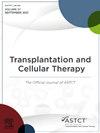Letermovir带来的生存获益的异质性。
IF 4.4
3区 医学
Q2 HEMATOLOGY
引用次数: 0
摘要
背景:基于个体患者特征的治疗效果变化——即治疗效果异质性或效果修饰——最近得到了极大的关注。先前的一项临床试验及其事后分析表明,莱特莫韦(LTV)可能比其他患者更能降低死亡率。我们假设LTV的生存益处根据每个患者的具体特征而不同。目的:本研究旨在确定与LTV显著生存获益相关的患者特征。研究设计:2018年至2022年间接受移植的患者随机分为训练组(n=5779)和验证组(n=2865)。我们开发了两个模型:一个使用带有相互作用项(PI)的比例风险模型,另一个使用现代机器学习(ML)方法来检测生存获益的异质性,特别是识别与LTV更大获益相关的患者特征。结果:在我们的队列中,60%的患者接受LTV作为预防。在训练队列中,最终的PI模型,使用加性相互作用,确定高龄(≥60),高合并症(HCT- ci≥3),脐带血(UCB)和单倍体相同HCT后环磷酰胺是高度有益的因素。同时,ML模型使用因果森林算法,根据估计的个体治疗效果将前60%的患者分类为高效益组。在验证组中,PI和ML模型分别有67.1%和59.9%的患者被认为是高效益的。高效益组6个月NRM (LTV vs.无LTV)的绝对差异(PI模型:9.8% vs. 16.3%;ML模型:11.3% vs. 16.3%)大于低效益组(PI模型:4.3% vs. 6.9%;ML模型:4.1% vs. 6.2%)。大多数高龄、高合并症或UCB患者(bbb80 %)被ML模型归类为高效益,支持PI模型的鲁棒性。结论:我们的模型成功地识别了那些可以通过LTV预防经历较低NRM的患者,强调了个性化医疗的重要性。本文章由计算机程序翻译,如有差异,请以英文原文为准。
Heterogeneity of Survival Benefit Conferred By Letermovir
Variation in treatment effects based on individual patient characteristics—known as treatment effect heterogeneity or effect modification—has recently gained significant attention. A previous clinical trial and its post hoc analysis suggested that letermovir (LTV) may reduce mortality more in some patients than in others. We hypothesized that the survival benefit of LTV differs according to each patient’s specific characteristics. This study aimed to identify patient characteristics that are associated with significant survival benefits from LTV. Patients who underwent transplantation between 2018 and 2022 were randomly divided into training (n = 5779) and validation groups (n = 2865). We developed two models: one using a proportional hazards model with interaction terms (PI), and another using a modern machine learning (ML) approach to detect heterogeneity in the survival benefit—specifically, to identify patient characteristics associated with greater benefit from LTV. In our cohort, 60% of patients received LTV as prophylaxis. In the training cohort, the final PI model, using additive interactions, identified advanced age (≥60), high comorbidities (HCT-CI ≥3), umbilical cord blood (UCB), and haploidentical HCT with post cyclophosphamide (PTCy Haplo) as highly beneficial factors. Meanwhile, the ML model, using a causal forest algorithm, classified the top 60% of patients based on the estimated individual treatment effect as the high benefit group. In the validation group, 67.1% and 59.9% of patients were considered to be high benefit by the PI and ML models, respectively. The absolute difference in 6-month NRM (LTV versus no LTV) in the high benefit group (PI model: 9.8% versus 16.3%; ML model: 11.3% versus 16.3%) was greater than that in the low benefit group (PI model: 4.3% versus 6.9%; ML model: 4.1% versus 6.2%). Most patients (>80%) with advanced age, high comorbidities, or UCB were classified as high benefit by the ML model, supporting the robustness of the PI model. Our models successfully identified patients who could be expected to experience lower NRM with LTV prophylaxis, underscoring the importance of personalized medicine.
求助全文
通过发布文献求助,成功后即可免费获取论文全文。
去求助
来源期刊

Transplantation and Cellular Therapy
Medicine-Hematology
CiteScore
7.00
自引率
15.60%
发文量
1061
审稿时长
51 days
 求助内容:
求助内容: 应助结果提醒方式:
应助结果提醒方式:


